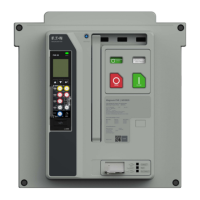30
7. Maintaining the PXR trip unit
POWER XPERT® RELEASE TRIP UNIT FOR MAGNUM PXR CIRCUIT BREAKERS MN013015EN January 2022 www.eaton.com
7. Maintaining the PXR trip unit
7.1 Troubleshooting
Table 12. Troubleshooting matrix.
Symptom Probable cause Possible solutions Reference
The trip unit
status LED is not
blinking.
No auxiliary (control) power or sufficient current is not
flowing through the circuit breaker sensors to power the trip
unit.
Connect +24 Vdc and ground auxiliary
power to circuit breaker terminals 19 and
20 and observe the status LED.
See Section 2.1 - Status indicator and
4.5 - Auxiliary control power.
Breaker trips on
ground fault.
There actually is a ground fault. Find the location of the fault.
On 3-pole, 4-wire residual systems, the neutral current
sensor may not match the trip unit setting or be properly
connected.
Check the ground fault setting is residual
or source/zero ground. Check that the
connections from the neutral current
sensor to the breaker are not reversed.
Check that the sensor type matches the
trip unit selection (iron core vs Rogowski).
See Section 3.6 - Ground fault
settings.
High inrush phase currents may cause fictitious ground
pickup momentarily.
If the zone interlocking function is
employed, connect a jumper from Z
out
to
Z
in
to provide some time delay.
See Section 3.6.4 - Ground fault zone
selective interlocking.
The trip unit is malfunctioning. Replace the trip unit. See Section 7.2 - Replacing the trip
unit.
Breaker trips
too rapidly on
ground fault
or short delay
(zone selective
interlocking not
used).
ZSI function is ON. Check the ZSI setting in the Setting menu
is OFF.
See Section 3.9 Zone selective
interlocking (ZSI)
The trip unit settings are not correct. Is I
2
t slope or flat
selected?
Change the ground fault or short delay
settings.
See Section 3.3 - Short circuit
settings and 3.6 - Ground fault
settings
The trip unit is malfunctioning. Replace the trip unit.
Neutral readings
incorrect
or tripping
unexpectedly.
Neutral sensor connected is not matched to selected option Make sure that neutral sensor selection is
set for Rogowski or iron-core CT to match
what is connected.
See Section 4.1 Neutral sensors
The breaker trips
too rapidly on long
delay.
Long time memory is selected. Disable the long time memory for long
delay times setting.
See Section 3.2.1 - Long delay
thermal memory
The trip unit settings are not correct. Change the long delay settings. See Section 3.2 - Overload/long delay
settings.
The primary
injection current
source is not
putting out the
correct current.
Primary injection testing pickup and trip times are not
correct.
Use an oscilloscope with a current probe
to accurately verify current values, times,
and that there are no inrush spikes of
current observed.
Single phase testing. When testing single phase, the current
can “bleed” into other un-energized
phases and reduce the value of current in
the testing phase.
It is possible, when using the high current “pulse” testing
technique, to create a long time memory trip as a result of
the cumulative action of the short duration currents.
Disable the long time memory feature for
long delay time setting.
See Section 3.2 - Overload/long
delay settings and 3.2.1 - Long delay
thermal memory.
Precise pickup levels are difficult to control and repeat for
primary injection testers as high current levels.
Use functional current testing (remote) via
USB/PXPM.
See Section 6.4.1 - Secondary
injection test.
Cause of trip LEDs
are flashing and
breaker is closed.
The trip unit was not reset from a previous event. Depress the Reset push button to clear
the LED or test flashing.
See Section 2.7 - Reset button.
The battery voltage is too low to reset the latch circuit on
the cause of trip LEDs.
Replace the battery then press the Reset
push button.
See Section 7.3 - Replacing the
battery.
The LCD display is
not energized.
No auxiliary power when the current through the breaker
is less than the minimum current requirement for the LCD
display.
Apply auxiliary power. See Section 4.5 - Auxiliary control
power and 4.6 - Secondary wiring
terminals for Magnum PXR.

